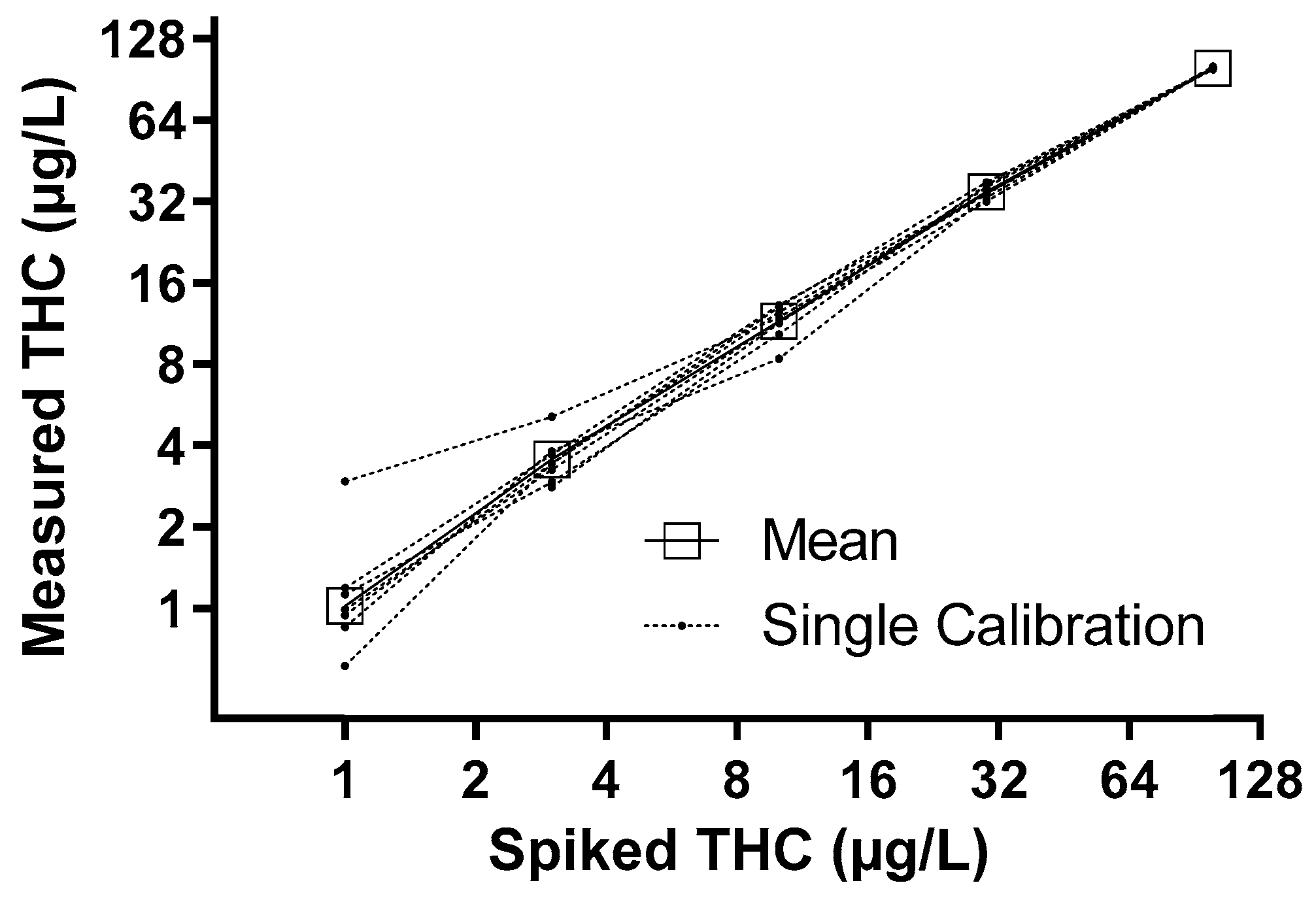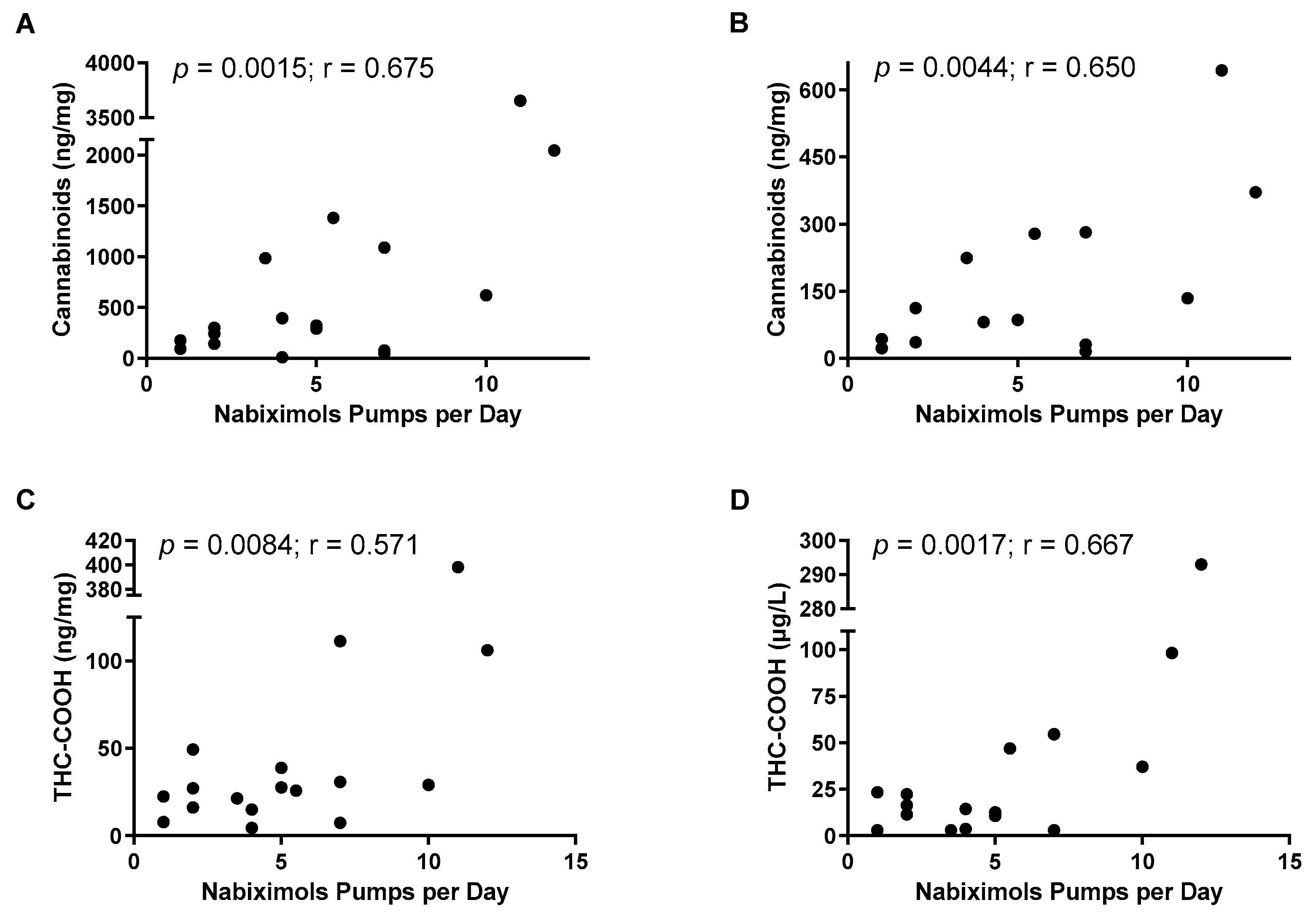Correlation of Nabiximols Dose to Steady-State Concentrations of Cannabinoids in Urine Samples from Patients with Multiple Sclerosis
Abstract
1. Introduction
2. Materials and Methods
2.1. Patients
2.2. Sample Preparation
2.3. Immunological Determination
2.4. GC/MS Analysis
2.5. Statistics
3. Results
| Patient Number | THC-COOH/THC Ratio |
|---|---|
| 1 | >3.6 |
| 2 | >11.5 |
| 3 | NA |
| 4 | 62.22 |
| 5 | 250.5 |
| 6 | >22.3 |
| 7 | 12.1 |
| 8 | >10.6 |
| 9 | <0.67 |
| 10 | 44.2 |
| 11 | 12.7 |
| 12 | 20.2 |
| 13 | 9.3 |
| 14 | 14.5 |
| 15 | 1.07 |
| 16 | 0.76 |
| 17 | >16.3 |
4. Discussion
Author Contributions
Funding
Institutional Review Board Statement
Informed Consent Statement
Data Availability Statement
Conflicts of Interest
References
- Smith, P.F. New approaches in the management of spasticity in multiple sclerosis patients: Role of cannabinoids. Ther. Clin. Risk Manag. 2010, 6, 59–63. [Google Scholar] [CrossRef] [PubMed][Green Version]
- Zettl, U.K.; Rommer, P.; Hipp, P.; Patejdl, R. Evidence for the efficacy and effectiveness of THC-CBD oromucosal spray in symptom management of patients with spasticity due to multiple sclerosis. Ther. Adv. Neurol. Disord. 2016, 9, 9–30. [Google Scholar] [CrossRef] [PubMed]
- Torres-Moreno, M.C.; Papaseit, E.; Torrens, M.; Farré, M. Assessment of efficacy and tolerability of medicinal cannabinoids in patients with multiple sclerosis: A systematic review and meta-analysis. JAMA Netw. Open 2018, 1, e183485. [Google Scholar] [CrossRef]
- Contin, M.; Mancinelli, L.; Perrone, A.; Sabattini, L.; Mohamed, S.; Scandellari, C.; Foschi, M.; Vacchiano, V.; Lugaresi, A.; Riva, R. Tetrahydrocannabinol/Cannabidiol Oromucosal Spray in Patients with Multiple Sclerosis: A Pilot Study on the Plasma Concentration-Effect Relationship. Clin. Neuropharmacol. 2018, 41, 171–176. [Google Scholar] [CrossRef]
- Notcutt, W.G. Clinical use of cannabinoids for symptom control in multiple sclerosis. Neurotherapeutics 2015, 12, 769–777. [Google Scholar] [CrossRef] [PubMed]
- Volicer, L.; Stelly, M.; Morris, J.; McLaughlin, J.; Volicer, B.J. Effects of dronabinol on anorexia and disturbed behavior in patients with Alzheimer’s disease. Int. J. Geriatr. Psychiatry 1997, 12, 913–919. [Google Scholar] [CrossRef]
- Wade, D.T.; Makela, P.M.; House, H.; Bateman, C.; Robson, P. Long-term use of a cannabis-based medicine in the treatment of spasticity and other symptoms in multiple sclerosis. Mult. Scler. 2006, 12, 639–645. [Google Scholar] [CrossRef]
- Schoedel, K.A.; Chen, N.; Hilliard, A.; White, L.; Stott, C.; Russo, E.; Wright, S.; Guy, G.; Romach, M.K.; Sellers, E.M. A randomized, double-blind, placebo-controlled, crossover study to evaluate the subjective abuse potential and cognitive effects of nabiximols oromucosal spray in subjects with a history of recreational cannabis use. Hum. Psychopharmacol. 2011, 26, 224–236. [Google Scholar] [CrossRef]
- Nadulski, T.; Sporkert, F.; Schnelle, M.; Stadelmann, A.M.; Roser, P.; Schefter, T.; Pragst, F. Simultaneous and sensitive analysis of THC, 11-OH-THC, THC-COOH, CBD, and CBN by GC-MS in plasma after oral application of small doses of THC and cannabis extract. J. Anal. Toxicol. 2005, 29, 782–789. [Google Scholar] [CrossRef]
- Karschner, E.L.; Darwin, W.D.; Goodwin, R.S.; Wright, S.; Huestis, M.A. Plasma cannabinoid pharmacokinetics following controlled oral delta9-tetrahydrocannabinol and oromucosal cannabis extract administration. Clin. Chem. 2011, 57, 66–75. [Google Scholar] [CrossRef]
- Stott, C.; White, L.; Wright, S.; Wilbraham, D.; Guy, G. A Phase I, open-label, randomized, crossover study in three parallel groups to evaluate the effect of Rifampicin, Ketoconazole, and Omeprazole on the pharmacokinetics of THC/CBD oromucosal spray in healthy volunteers. Springerplus 2013, 2, 236. [Google Scholar] [CrossRef] [PubMed]
- Leussink, V.I.; Husseini, L.; Warnke, C.; Broussalis, E.; Hartung, H.-P.; Kieseier, B.C. Symptomatic therapy in multiple sclerosis: The role of cannabinoids in treating spasticity. Ther. Adv. Neurol. Disord. 2012, 5, 255–266. [Google Scholar] [CrossRef] [PubMed]
- Indorato, F.; Liberto, A.; Ledda, C.; Romano, G.; Barbera, N. The therapeutic use of cannabinoids: Forensic aspects. Forensic Sci. Int. 2016, 265, 200–203. [Google Scholar] [CrossRef] [PubMed]
- Bergamaschi, M.M.; Barnes, A.; Queiroz, R.H.C.; Hurd, Y.L.; Huestis, M.A. Impact of enzymatic and alkaline hydrolysis on CBD concentration in urine. Anal. Bioanal. Chem. 2013, 405, 4679–4689. [Google Scholar] [CrossRef]
- Huestis, M.A.; Henningfield, J.E.; Cone, E.J. Blood cannabinoids. I. Absorption of THC and formation of 11-OH-THC and THCCOOH during and after smoking marijuana. J. Anal. Toxicol. 1992, 16, 276–282. [Google Scholar] [CrossRef]
- Cone, E.J.; Huestis, M.A. Relating blood concentrations of tetrahydrocannabinol and metabolites to pharmacologic effects and time of marijuana usage. Ther. Drug Monit. 1993, 15, 527–532. [Google Scholar] [CrossRef]
- Abraham, T.T.; Lowe, R.H.; Pirnay, S.O.; Darwin, W.D.; Huestis, M.A. Simultaneous GC-EI-MS determination of Delta9-tetrahydrocannabinol, 11-hydroxy-Delta9-tetrahydrocannabinol, and 11-nor-9-carboxy-Delta9-tetrahydrocannabinol in human urine following tandem enzyme-alkaline hydrolysis. J. Anal. Toxicol. 2007, 31, 477–485. [Google Scholar] [CrossRef]
- Brady, C.M.; DasGupta, R.; Dalton, C.; Wiseman, O.J.; Berkley, K.J.; Fowler, C.J. An open-label pilot study of cannabis-based extracts for bladder dysfunction in advanced multiple sclerosis. Mult. Scler. 2004, 10, 425–433. [Google Scholar] [CrossRef]
- Killestein, J.; Polman, C. The therapeutic value of cannabinoids in MS: Real or imaginary? Mult. Scler. 2004, 10, 339–340. [Google Scholar] [CrossRef]
- Wade, D.T.; Makela, P.; Robson, P.; House, H.; Bateman, C. Do cannabis-based medicinal extracts have general or specific effects on symptoms in multiple sclerosis? A double-blind, randomized, placebo-controlled study on 160 patients. Mult. Scler. 2004, 10, 434–441. [Google Scholar] [CrossRef]
- Collin, C.; Davies, P.; Mutiboko, I.K.; Ratcliffe, S. Randomized controlled trial of cannabis-based medicine in spasticity caused by multiple sclerosis. Eur. J. Neurol. 2007, 14, 290–296. [Google Scholar] [CrossRef] [PubMed]
- Notcutt, W.; Langford, R.; Davies, P.; Ratcliffe, S.; Potts, R. A placebo-controlled, parallel-group, randomized withdrawal study of subjects with symptoms of spasticity due to multiple sclerosis who are receiving long-term Sativex® (nabiximols). Mult. Scler. 2012, 18, 219–228. [Google Scholar] [CrossRef] [PubMed]
- Sellers, E.M.; Schoedel, K.; Bartlett, C.; Romach, M.; Russo, E.B.; Stott, C.G.; Wright, S.; White, L.; Duncombe, P.; Chen, C.-F. A Multiple-dose, randomized, double-blind, placebo-controlled, parallel-group QT/QTc study to evaluate the electrophysiologic effects of THC/CBD spray. Clin. Pharmacol. Drug Dev. 2013, 2, 285–294. [Google Scholar] [CrossRef]
- Flachenecker, P.; Henze, T.; Zettl, U.K. Long-term effectiveness and safety of nabiximols (tetrahydrocannabinol/cannabidiol oromucosal spray) in clinical practice. Eur. Neurol. 2014, 72, 95–102. [Google Scholar] [CrossRef] [PubMed]
- Russo, M.; Naro, A.; Leo, A.; Sessa, E.; D’Aleo, G.; Bramanti, P.; Calabrò, R.S. Evaluating Sativex® in neuropathic pain management: A clinical and neurophysiological assessment in multiple sclerosis. Pain Med. 2016, 17, 1145–1154. [Google Scholar] [CrossRef] [PubMed]
- Baselt, R.C. Disposition of Toxic Drugs and Chemicals in Man; Biomedical Publications: Foster City, CA, USA, 2008; pp. 1513–1518. [Google Scholar]


| Patient Number | Cannabinoid Plasma Concentration (µg/L) | Cannabinoid Urine Concentration (µg/L) | ||||||
|---|---|---|---|---|---|---|---|---|
| CBD | THC | 11-OH-THC | THC-COOH | CBD | THC | 11-OH-THC | THC-COOH | |
| 1 | <3 | <1 | <3 | 3.59 | <3 | <3 | <1 | <5 |
| 2 | <3 | <1 | <3 | 11.5 | <3 | <3 | 1.11 | 37.5 |
| 3 | <3 | <1 | <3 | <3 | 7.08 | <3 | 1.25 | 37.6 |
| 4 | <3 | 1.17 | <3 | 72.8 | 3.54 | <3 | <1 | <5 |
| 5 | <3 | 4.61 | 3.7 | 1155 | <3 | <3 | <1 | 30 |
| 6 | <3 | <1 | <3 | 22.3 | <3 | <3 | <1 | 17.9 |
| 7 | <3 | 24.2 | 7.73 | 293 | <3 | <3 | <1 | 144 |
| 8 | <3 | <1 | <3 | 10.6 | <3 | <3 | <1 | <5 |
| 9 | <3 | 4.46 | <3 | <3 | 3.83 | <3 | <1 | 8.72 |
| 10 | <3 | 1.06 | <3 | 46.9 | <3 | <3 | <1 | 32.1 |
| 11 | <3 | 1.84 | <3 | 23.3 | <3 | <3 | 1.7 | <5 |
| 12 | 4.89 | 4.85 | 14.2 | 98.2 | <3 | <3 | 1.29 | 173 |
| 13 | <3 | 3.98 | <3 | 37.1 | <3 | <3 | <1 | 48.3 |
| 14 | <3 | 3.77 | 3.75 | 54.5 | 5.52 | 4.58 | 3.49 | 116 |
| 15 | <3 | 11.8 | <3 | 12.6 | <3 | <3 | <1 | 11.3 |
| 16 | <3 | 18.9 | 9.82 | 14.3 | <3 | <3 | <1 | 6.53 |
| 17 | <3 | <1 | <3 | 16.3 | <3 | <3 | <1 | <5 |
| Patient Number | THC-COOH Ratio (Hydrolyzed/Non-Hydrolyzed); GC/MS | 11-OH-THC Ratio (Hydrolyzed/Non-Hydrolyzed); GC-MS | Cannabinoid Ratio (Hydrolyzed/Non-Hydrolyzed); Immunoassay |
|---|---|---|---|
| 1 | NP | NP | NP |
| 2 | NQ | 19.9 | NP |
| 3 | NQ | 12.4 | 0.805 |
| 4 | >2.44 | NQ | 0.971 |
| 5 | 10.8 | >6.9 | 0.455 |
| 6 | 2.7 | NQ | 0.746 |
| 7 | 5.7 | >32 | 0.363 |
| 8 | >3.9 | NQ | 0.343 |
| 9 | 2.9 | NQ | 0.359 |
| 10 | 20.9 | >32.6 | 0.403 |
| 11 | >4.7 | 2.9 | 0.479 |
| 12 | 6.1 | 77 | 0.347 |
| 13 | 10.8 | >34.4 | 0.433 |
| 14 | 3.8 | 16.5 | 0.516 |
| 15 | 2.6 | NQ | 0.587 |
| 16 | 8 | >7.8 | 0.409 |
| 17 | >3.5 | NQ | 0.459 |
Publisher’s Note: MDPI stays neutral with regard to jurisdictional claims in published maps and institutional affiliations. |
© 2022 by the authors. Licensee MDPI, Basel, Switzerland. This article is an open access article distributed under the terms and conditions of the Creative Commons Attribution (CC BY) license (https://creativecommons.org/licenses/by/4.0/).
Share and Cite
Birke, R.; Meister, S.; Winkelmann, A.; Hinz, B.; Walther, U.I. Correlation of Nabiximols Dose to Steady-State Concentrations of Cannabinoids in Urine Samples from Patients with Multiple Sclerosis. J. Clin. Med. 2022, 11, 3717. https://doi.org/10.3390/jcm11133717
Birke R, Meister S, Winkelmann A, Hinz B, Walther UI. Correlation of Nabiximols Dose to Steady-State Concentrations of Cannabinoids in Urine Samples from Patients with Multiple Sclerosis. Journal of Clinical Medicine. 2022; 11(13):3717. https://doi.org/10.3390/jcm11133717
Chicago/Turabian StyleBirke, Rüdiger, Stefanie Meister, Alexander Winkelmann, Burkhard Hinz, and Udo I. Walther. 2022. "Correlation of Nabiximols Dose to Steady-State Concentrations of Cannabinoids in Urine Samples from Patients with Multiple Sclerosis" Journal of Clinical Medicine 11, no. 13: 3717. https://doi.org/10.3390/jcm11133717
APA StyleBirke, R., Meister, S., Winkelmann, A., Hinz, B., & Walther, U. I. (2022). Correlation of Nabiximols Dose to Steady-State Concentrations of Cannabinoids in Urine Samples from Patients with Multiple Sclerosis. Journal of Clinical Medicine, 11(13), 3717. https://doi.org/10.3390/jcm11133717







